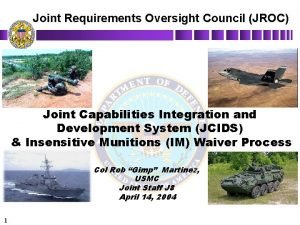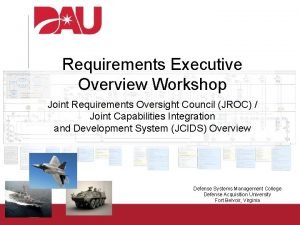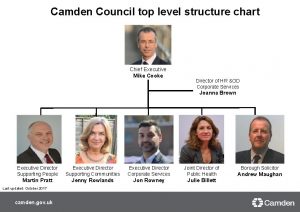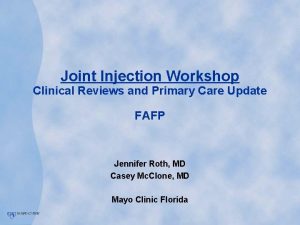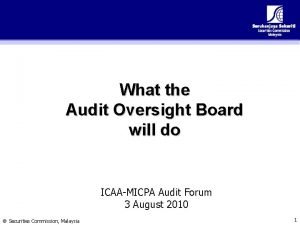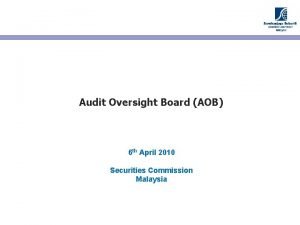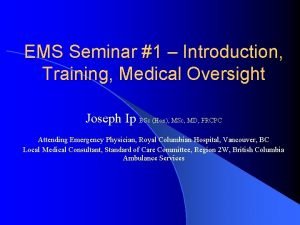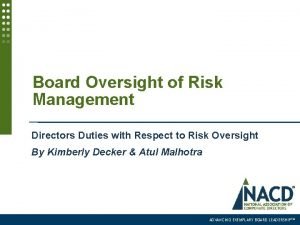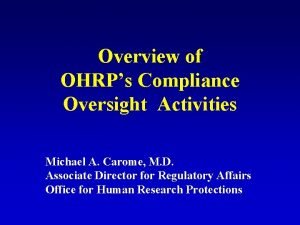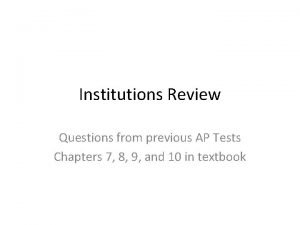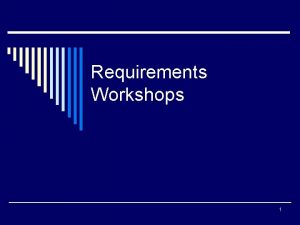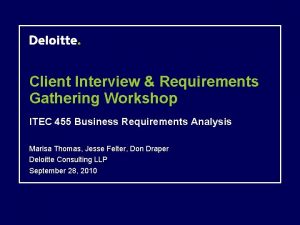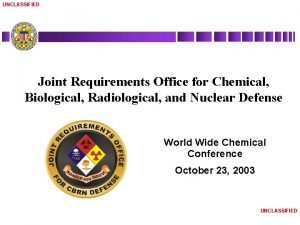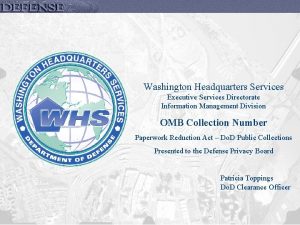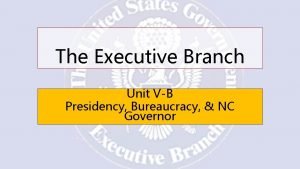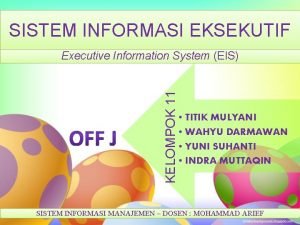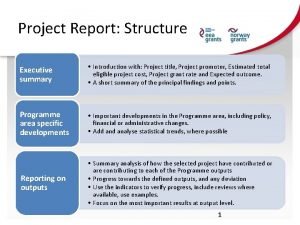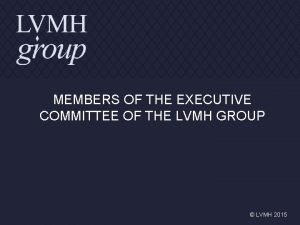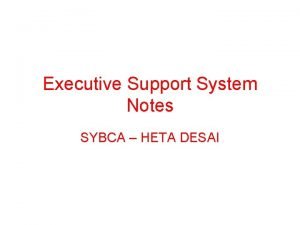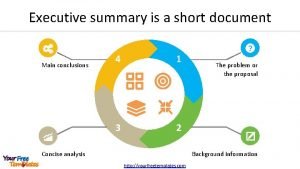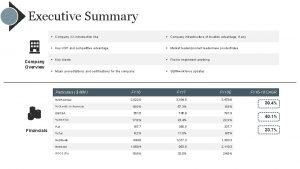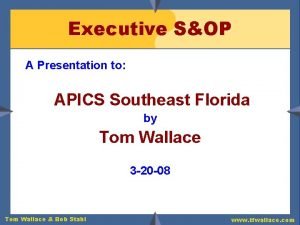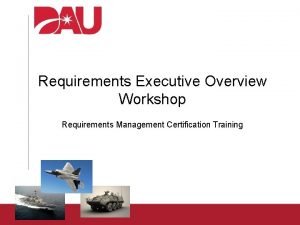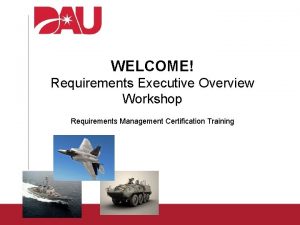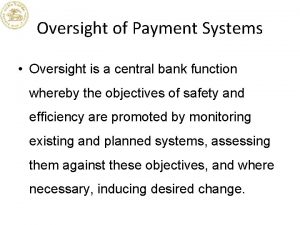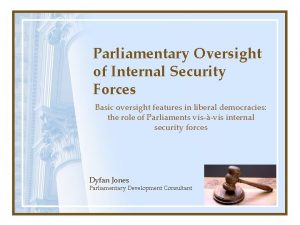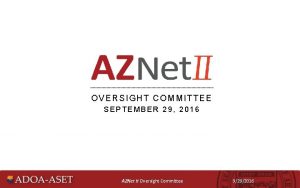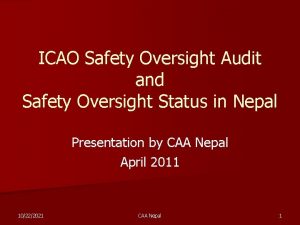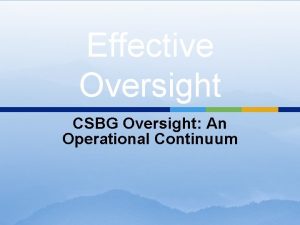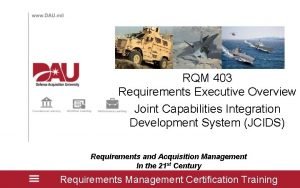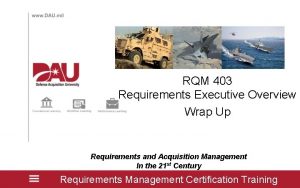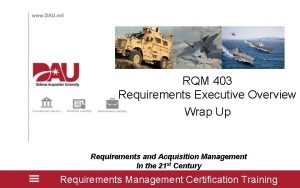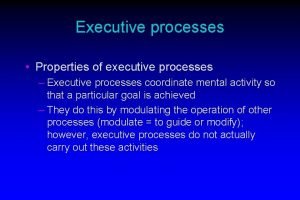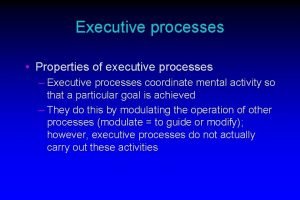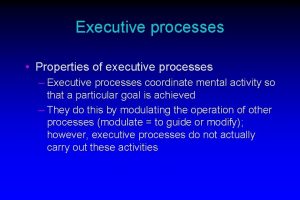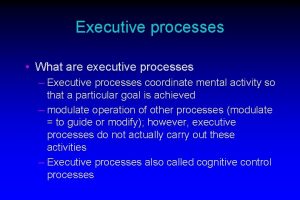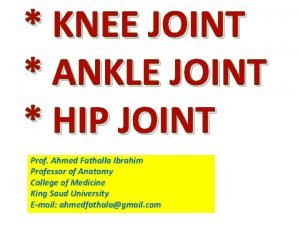Requirements Executive Overview Workshop Joint Requirements Oversight Council

























































- Slides: 57

Requirements Executive Overview Workshop Joint Requirements Oversight Council (JROC) / Joint Capabilities Integration and Development System (JCIDS) Overview Defense Systems Management College Defense Acquisition University Fort Belvoir, Virginia

Outline • The big picture? Why we have requirements… • The prior JCIDS updates? Quick review of 2012 and 2015 changes… • The upcoming JCIDS update? Continuing evolution… • Capability Requirement Portfolio Management… -------------Status: CJCSI 5123. 01 – version “G” signed out by DJS 12 Feb 2015 CJCSI 3170. 01 – version “I” signed out by DJS 23 Jan 2015 JCIDS Manual – JROCM signed, final version released 12 Feb 2015 (Errata versions posted to the JCIDS Wiki as needed – reflecting administrative clarifications/corrections; latest authorized version 18 Dec 2015) Tab 2 – JCIDS 2

Why do we have the JROC and JCIDS? • One reason: acquisition of materiel capabilities for the warfighter JCIDS DAS PPBE • But supporting acquisition is only part of the picture… More than any other body, the JROC is charged with shaping the force Tab 2 – JCIDS 3

Departmental Process Interactions Tab 2 – JCIDS 4

Requirements Tradeoffs Finding the balance between: Tab 2 – JCIDS CCMD near-term requirements to support CONPLANs and current missions and Services’ long range vision & investment plans Versatile, joint systems and Systems optimized for service missions Growing demands and Fiscal & political constraints Geographic specificity and Worldwide applicability Ambitious requirements and Achievable acquisition strategy Quantity matters and Quality (High-end capabilities) COST and PERFORMANCE (acceptable risk) 5

10 USC 181 (JROC) Tab 2 – JCIDS 6

Organizational Construct for the JROC Tab 2 – JCIDS 7

JCIDS Deliberate Process Touch Points DCR JCIDS Touch Points Program Updates Initial Capabilities Document (ICD): Specifies capability requirements and associated capability gaps which represent unacceptable operational risk. Recommends mitigating identified capability gap(s) with a nonmateriel capability solution, or some combination. A validated ICD is an entrance criterion necessary for each MDD. Capability Production Document (CPD): Specifies capability requirements, in terms of production KPPs, KSAs, and APAs, and other related information necessary to support production of a single increment of a materiel capability solution. A validated CPD is a requirement for the MS C decision point. Capability Development Document (CDD): Specifies capability requirements, in terms of developmental KPPs, KSAs, and APAs, and other related information necessary to support development of one or more increments of a materiel capability solution. A draft CDD is a requirement for the RFP release in support of the TMRR phase, and a validated CDD is a requirement for the development RFP release decision point and informs the MS B acquisition decision point. Joint Doctrine, Organization, Training, material, Leadership and Education, Personnel, Facilities, and Policy (DOTm. LPF-P) Change Recommendation (DCR): Recommends mitigating identified capability gaps with non-materiel capability solutions, through changes to one or more of the eight DOTm. LPF-P areas. When a DCR is not generated from a previously validated ICD, it specifies the capability requirements and associated capability gaps for review and validation. 8

Process Lanes 2 -yr efforts • Urgent Threat: CCMD Driven. Urgent and compelling to prevent loss of life and/or mission failure during current operations. Require little tech development and can be resolved in less than two years. The J 8 Deputy Director for Requirements (DDR) validates • Emergent Threat: CCMD Driven. Supports accelerated acquisition of capabilities needed for an anticipated or pending contingency operation. VCJCS verifies, JCB or JROC validates • Deliberate Planning: Service, CCMD or Agency Driven. Traditional route for capabilities that require significant tech development and/or are not urgent or compelling in nature. Tab 2 – JCIDS

Desired End-State Take the Lead in Shaping the Force – Back to JROC and CJCS Title 10 – Debate the difficult issues and make difficult choices earlier – Better upfront fidelity on cost/schedule/performance tradeoffs – More analytic rigor and risk/portfolio analysis – Stronger emphasis on prioritizing capability requirements – Better end-to-end traceability to facilitate decision making: Missions – Requirements – Acquisition and DOTm. LPF-P – Budget. – More dynamic/iterative process throughout a program’s lifecycle. (Revisit as necessary…strategy shifts, threat changes, etc. ) Make the difficult choices throughout the requirements continuum… Tab 2 – JCIDS 10

What did we change in Jan 2012? Tab 2 – JCIDS

2012 Changes (part 1 of 2) • Consolidated Guidance: CJCSI 5123. 01 (JROC Charter), CJCSI 3170. 01 (JCIDS), and the JCIDS Manual are the core products – CJCSI 3137. 01 (FCBs) and CJCSI 3470. 01 (JUONs) cancelled, with content absorbed into the three core documents. • Requirements Training: – Mandated Requirements Management Certification Training (RMCT) • Implemented Study Notification/Repository: – Centralized repository for CBAs and other studies/analyses supporting JCIDS documents to facilitate visibility, collaboration, and re-use • Documents: – Page limits: ICD (10), DCR (30), CDD (45), CPD (40) – Implemented “IT Box” construct – IS ICD. – Institutionalized JUONs and JEONs for urgent/emergent needs. – Clarified joint visibility requirements for all documents – Clarified submission of higher classification documents/issues – (June 2012) Introduced alternate/streamlined document formats Tab 2 – JCIDS 12

2012 Changes (part 2 of 2) • Organizations: – – – Added CCMDs as full members of JROC Disestablished the Building Partnerships FCB Established SAP Integration Group Established Joint Requirements Assessment Division (JRAD) Clarified Joint Staff J-7 Role and DOTm. LPF-P Endorsement • Staffing: – Streamlined staffing: Deliberate: 83 days. Urgent/Emergent : 15 -31 days – Placed focus on finding “knee in the curve” tradeoffs – Post-Ao. A review of results/recommendations and draft KPP review • Post-Validation: – More robust Tripwire Process – for cost, schedule, quantity changes. – Institutionalized Capability Gap Assessment (CGA) Process – Introduced a post-fielding assessment for JUONs/JEONs Tab 2 – JCIDS 13

What did we change in 2015? Tab 2 – JCIDS

2015 Changes (part 1 of 2) • Consolidated Guidance: CJCSI 5123. 01 (JROC Charter), CJCSI 3170. 01 (JCIDS), and the JCIDS Manual are still the core products – CJCSI 3312. 01 (Intelligence Certification), CJCSI 6212. 01 (Net-Ready KPP), and JWSTAP Charter (Weapon Safety Endorsement) cancelled, with content absorbed into the three core documents – Significant revision of Intelligence Certification content • Roles/Responsibilities: – Expanded guidance for stakeholder roles/responsibilities in CJCSI 5123 • Developing Requirements: – Refined CBA guidance – Focus on leveraging DODAF to streamline development activities – ICD Attributes: “Initial Objective Values” vice “Minimum Values” – Enable more robust leverage of S&T efforts to satisfy requirements – Introduces the Capability-Mission Lattice as a framework for traceability to operational missions – Increased focus on ensuring attributes are measurable and testable Tab 2 – JCIDS 15

2015 Changes (part 2 of 2) • Documents: – Streamlines document formats (starts with June 2012 alternate formats) – Extends “IT Box” construct to IS CDD – Aligns affordability sections of CDDs/CPDs with new DODI 5000. 02 – Content/Endorsement guides for Mandatory KPPs, Weapon Safety endorsement, DOTm. LPF-P endorsement, and Intelligence Certification – Requires “validation page” (and waivers, if applicable) to be combined with JCIDS documents • Staffing: – Merges JSDs of Joint Information and Independent – Integrates Common gatekeeping with DCMO for Defense Business Systems – Enhances guidance for submission and review of higher classification documents/issues, including SAP/SAR and ACCM • Portfolio Management: – Consolidates “post validation processes” and “prioritization” guidance into the “portfolio management” guidance. Tab 2 – JCIDS 16

2016 -2017: The evolution continues… Tab 2 – JCIDS

JCIDS Reform Status Overview • Congressional Engagement – 2017 NDAA Draft language affecting JROC (10 USC 181) – Awaiting approved language and resulting direction • Evolved guidance – Keep requirements process transparent – Speed up the process, reduce paperwork, shed what is not valuable to scope – Track / measure what is important • Still focused on…. – – – Tab 2 – JCIDS Determine what should go to the JROC Focus on joint military capability requirements Minimize touch points between sponsor and Joint Staff Maintain appropriate level of oversight and analytical rigor Provide acquisition community with approved, actionable capability requirements

Proposed Updates / Schedule • • • JCIDS will remain “as is” for now…… Name change not required…JCIDS = The Do. D Requirements Process Maintain/Update CJCSI 3170. 01 and CJCSI 5123. 01; possibly re-establish CJCSM 3170 vice current on-line Manual Mandatory KPPs – Reduce to only those currently required by statute, delegate to Sponsors (Survivability, FP, Energy) – Emphasis on capability solution’s “Warfighting” performance attributes JSDs reduced to JROC Interest, JCB Interest, and Joint Information Reviewing whether Do. DAF views are essential for requirements decisions, to include potential to reduce the number necessary Reviewing whether the CDD should be validated prior to MS A or prior to MS B – Review of CDD for MS C only by exception – Continue to review Ao. A for JCB/JROC Interest items prior to MS A Reviewing the need to establish an additional requirement document to reflect changes being made to Do. DI 5000. 02 in relation to 2016 NDAA guidance Pursue KMDS improvements, to include a separate on-going study Schedule: Drafting of updated documents to occur over the next several months to incorporate items above in preparation of formal staffing of proposed updated JCIDS guidance (to coincide with 2017 NDAA release) Tab 2 – JCIDS

Capability Requirement Portfolio Management The Key to Robust Integration in an Uncertain Future Tab 2 – JCIDS

Understanding Portfolio Dependencies • The key objective of the JCIDS process is to facilitate the JROC and its subordinate boards, as informed by other stakeholders: – Manage/prioritize capability requirements within and across the capability requirement portfolios to inform assessments, processes, and activities across DOD. (Statutory roles of JROC and other stakeholders. ) – Understand capability dependencies, relationship to the Tasks (UJTs) they enable, and the missions they support. – Maintain awareness of historical decisions and rationale, including past cycles of CGA and PBR, to make informed assessments and decisions. Tab 2 – JCIDS 21

Innovation through S&T Integration Tab 2 – JCIDS 23

Continuous Assessment • Changes may require reassessment of the capability requirement portfolios to ensure that any impacts are identified and appropriate actions taken to best serve the joint force. – Revisiting previously validated capability requirements for potential adjustment in light of the updated guidance. – Initiating studies or analyses to assess identified gaps or overlaps in the capability requirement portfolios. – Using capability requirement portfolio assessments to inform other Departmental processes or decision making, such as in PBR. Tab 2 – JCIDS 24

Questions? • • • Or later/online: NIPR: https: //www. intelink. gov/wiki/JCIDS SIPR: https: //www. intelink. sgov. gov/wiki/JCIDS • • • J-8/JRAD (Joint Requirements Assessment Division) COL Stephanie J. Tutton, USA (stephanie. j. tutton. mil@mail. mil) Lt Col Matt Edmundson, USAF (matthew. s. edmonson. mil@mail. mil) • • J-8/JCD (Joint Capabilities Division) Col Shane “Boxcar” Conrad, USMC (shane. b. conrad. mil@mail. mil) Mr. Randy Wood (randolph. l. wood 6. civ@mail. mil) Mr. Matthew Ghormley (matthew. ghormley@dau. mil) Tab 2 – JCIDS

BACKUPS Tab 2 – JCIDS

Primary Stakeholders/Equities Capability Requirement Documents Section Primary Equities ICD Joint DCR CDD/CPD Joint Staff Other/Advisors Operational Context J 3/J 5 CAPE (for ISCs) Threat Summary J-2/IRCO USD(I) Capability Requirements / Capability Gaps Capability Discussion Program Summary FCBs, J-8/JRAD, J 8/CAD, J-8/PBAD KPPs/KSAs/APAs Other Attributes MDA, ASD(A), ASD(R&E), ASD(L&MR), USD(I), DOD CIO, DASD(T&E), DOT&E Mandatory KPPs J 8/FPD, J 4/MXD, J 6/C 4 CD, J 4/ED DASD(MR), DOD CIO, ASD(OEPP) Spectrum Requirements J-6/C 4 CD DOD CIO, USD(AT&L) – C 3 & Cyber Intelligence Supportability J-2/IRCO USD(I) Weapon Safety Assurance J 8/FPD JWSTAP, ASD(L&MR) Technology / Manufacturing Readiness FCBs, J-8/JRAD, J 8/CAD, J-8/PBAD ASD(R&E) Non-materiel Approaches Change Recommendations DOTm. LPF-P Considerations J-1, J-4, J-5, J-7, J-8/FD USD(P), USD(P&R), ASD(L&MR) Recommendations Resource Summary Program Affordability Validation Authority MDA, CAPE Tab 2 – JCIDS 27

JCIDS Guidance Documents I Tab 2 – JCIDS 28

DODAF Viewpoints Tab 2 – JCIDS 29

JCIDS and Acquisition (Do. DI 5000. 02, Jan 2015) • Analysis of Alternatives (Ao. A) • Acquisition Strategy • Test & Evaluation (T&E) Master Plan • Operational Planning • JCTDs/JUON/JEON/ (TEMP) • CBAs & Other Studies Experiments • System Engineering • Exercises/Lessons • JIEDDO Initiatives Learned • Defense Business Sys Plan (SEP) • Life Cycle Sustainment Plan Outputs (LCSP) • Mission & Problem • Operational Risk • Operational Mode • Capability Gaps • Non-Materiel Summary/Mission • Tasks Approaches Profile (OMS/MP) • Performance • Materiel Approaches • Conditions • Recommendations Materiel Identification of Capability Requirements President, SECDEF & Chairman: • Strategic Guidance OSD/Joint Staff • Integrated Security Constructs • Joint Concepts Development Decision Activity Select Joint Develop Concept CONOPS Capabilities-Based Assessment / Other ICD CCMD Materiel Solution Analysis • Technology Demonstrated • Initial Key Performance Parameters/ Key System Attributes (KPPs/KSAs) • Acquisition Strategy (AS) • TEMP • SEP • LCSP • OMS/MP MS A Draft CDD Analysis of Alternatives (Ao. A) CDD RFP Val Rel Technology Maturation & Risk Reduction Competitive Prototyping • Final Design • Developmental T&E (DT&E) • Operational Assessments (OA) • Revise KPPs/ KSAs • AS • Acquisition Pgm Baseline (APB) • TEMP • SEP • LCSP • OMS/MP MS B CDD Engineering & Manufacturing Development • Low Rate Initial Production (LRIP) • Initial Operational T&E (IOT&E) • Full-Rate Prod (FRP) • AS • LRIP • APB • FOT&E • TEMP • SEP • LCSP • OMS/MP MS C FRP CPD Production & Deployment Develop, test, LRIP & Full Rate Production, deploy to warfighter, IOC Military Services JROC action for JROC Interest programs (ACAT I & IA) Validates ICD SECDEF Validates CDD Identify Capability Requirements Select Materiel Solution Develop, Test, Produce & Field Getting The Front End Right is Key Tab 2 – JCIDS Validates CPD OSD (AT&L, CAPE), Services and OSD (DOT&E) -- Joint Staff (JROC) Joint Staff / Joint Requirements Oversight Council / OSD Policy Reviews Ao. A Results 30

Capability Requirement Documents • Joint DCR – DOTm. LPF-P Change Recommendation – When Sponsor proposes that a Joint Non-Materiel Solution is appropriate – Non-Materiel Solutions • • Tab 2 – JCIDS Change doctrine Reorganize Train DOD personnel differently Acquire commercial or non-developmental items, or additional quantities of existing items Adjust the professional development of the joint leader Add or reassign personnel Move or realign facilities Change policy 31

Capability Requirement Documents • Initial Capabilities Document (ICD) (MS A) – Documents Capability Requirements, and associated Capability Gaps, based upon Capabilities-Based Assessment (CBA) Results – Identifies relevant attributes and required operational effectiveness (Mo. Es - mission/task based – system agnostic) – Documents the recommendation(s) for a path forward to close or mitigate one or more capability gaps – Predecessor for executing the Analysis of Alternatives and then drafting the Capabilities Development Document Tab 2 – JCIDS 32

Capability Solution Documents • Capability Development Document (MS B) – Defines performance parameters for a specific capability solution intended to satisfy validated capability requirements • Identifies quantified KPPs, KSAs, and APAs (Mo. Ps) • Attributes should be Authoritative, Measurable, and Testable – Describes DOTm. LPF-P constraints or enablers associated with the solution – May describe multiple increments of a capability solution – Provides key inputs to the acquisition strategy and the Acquisition Program Baseline (APB) Tab 2 – JCIDS 33

Capability Solution Documents • Capability Production Document (CPD) (MS C) – Supports Production and Development of one increment • Refines CDD KPPs, KSAs, and APAs as needed. (Mo. Ps) • Provides Authoritative, Measurable, Testable parameters – Support Production, Testing, and Deployment • May describe Incremental Production and Deployment – Generally, No New Requirements – Must meet validated operational Capability Requirements from the ICD (Mo. Es) Tab 2 – JCIDS 34

JCIDS Document Tracks Joint Staffing Designator (JSD) FCB review & JROC Interest ACAT I/IA programs & Joint DCRs JCB Interest prioritization JCB KM/DS staffing & comment Review FCB review & prioritization ACAT II & below with impact on interoperability Joint Integration JROC KM/DS staffing & comment JCB FCB review & prioritization ACAT II & below that require endorsements & certifications KM/DS staffing & comment FCB review & Sponsor prioritization Joint Information ACAT II & below that do not require endorsements & certifications KM/DS staffing & comment Validation Authority KM/DS: Knowledge Management/Decision Support tool Tab 2 – JCIDS 35

Requirements Decision Chain JROC DECISION CHAIN JROC MEMBERSHIP Chair: VCJCS. Advises the CJCS JROC Owns JCIDS; Validates JROC Interest documents; final authority JCB Validates JCB Interest documents; assists JROC FCBs Reviews documents; prioritizes within portfolio; makes validation recommendation to JCB/JROC documents & prioritizes FCB WGs Reviews prior to FCB review Statutory Council Members: • Vice Chief of Staff, Army • Vice Chief of Naval Operations • Vice Chief of Staff, Air Force • Assistant Commandant of the Marine Corps • Combatant Commands* (Commander or Deputy Commander) JROC: Joint Requirements Oversight Council JCB: Joint Capability Board FCBs: Functional Capability Boards (Force Support, Battlespace Awareness, Force Application, Logistics, Protection, C 4/Cyber. ) FCB WGs: FCB Working Groups Tab 2 – JCIDS *Unless otherwise directed to participate by the JROC Chairman, CCMD representatives are highly encouraged to participate as voting members of the JROC when matters related to the area of responsibility or functions of that command will be under consideration by the JROC. USD(AT&L), Dir, CAPE, USD(Comptroller), DOT&E, and USD(Policy) attend as statutory JROC advisors 36

Functional Capability Boards & Sponsoring Organizations C 4 / Cyber Brig Gen Murphy JS J 6 Protection** COL Hoggard (acting) JS J 8 Battlespace Awareness Logistics* Mr. Canfield JS J 2 Mr. Hawkins JS J 4 Force Support (includes BP) *DASD for Supply Chain Integration, Ms. Reardon, serves as Log FCB co-chair. **J 8/DDJIAMDO, RDML Cashman, serves as Protection FCB co-chair for IAMD issues. Maj. Gen Clardy JS J 8 Force Application Maj. Gen Clardy JS J 8 FCB Membership: (O-6 level) Services Combatant Command Reps OSD (AT&L) OSD (I) USec. AF (Space) Tab 2 – JCIDS DOD CIO OSD (C) D, CAPE OSD (P) DIA Rep (Threat) ODNI/IRB Other Do. D Agencies as necessary Additional JCA: • Corporate Management and Support • No FCB, but partly covered by OSD/DCMO 37

Summary of the Deliberate JCIDS Process • Materiel Solutions – Initial Capabilities Document (ICD) – Capability Development Document (CDD) – Capability Production Document (CPD) • Non-Materiel Solutions – Joint DOTm. LPF-P Change Recommendation (DCR) • Operational Requirements Development is a Team Effort; All Stakeholders Should be Involved; Involve the User in Technical Requirements Development Tab 2 – JCIDS 38

Rapid Response Tab 2 – JCIDS 39

Joint Urgent & Emergent Operational Needs • Every Service has a Rapid Response Procedure • The Joint Rapid Response Lanes are the Joint Urgent Operational Needs (JUON) and Joint Emergent Operational Needs (JEON) • JUON/JEON Validation and Resourcing Involves – VCJCS/JCB/JROC – The Gatekeeper (J 8 Deputy Director for Requirements (DDR)) – The Joint Rapid Acquisition Cell (JRAC) – Functional Capabilities Boards (FCBs) and Working Groups – The Military Services, Defense Agencies, ISR TF and Joint Improvised Explosive Device Defeat Organization (JIEDDO) Tab 2 – JCIDS 40

Who Initiates an Urgent/Emergent Need? • An Urgent/Emergent Request Must Come from: – A Joint Force Commander – A Service Component Commander – A commander’s delegated representative • Services Validate Service-Unique Urgent/Emergent Need • JUONs/JEONs are Endorsed by the Combatant Commanders and Validated by the Joint Staff/DDR (for JUONs) and JCB/JROC (for JEONs) Tab 2 – JCIDS 41

Urgent/Emergent Staffing Tab 2 – JCIDS 42

Challenge of Rapid Acquisition « Future Focused « Very Structured Process « Evolved Requirements « Analysis of Alternatives « Lengthy Development « High Visibility on Program « Large Investment immediate À À À À À Tab 2 – JCIDS Now-focused More ad hoc process Broad requirement Quick assessment of alternatives Limited development High visibility on results Limited investment Very Limited Feedback Transition to Po. R 43

Intelligence Integration/Support to Requirements and Acquisition • • Additional focus on threat and intelligence supportability Intel Certification is a statement of adequacy and assesses whether the intelligence architecture and infrastructure will be available, suitable, and sufficient to support joint military requirements. – Certifies: (1) DIA or service validation of Threat information and references; and, (2) adequacy of requirements and supportability in nine Intelligence Support categories – Conditional Certification requires sponsors provide additional information prior to next milestone to receive final certification • Recent inclusion of language from intelligence certifications in JCIDS capability JROCMs • • • – Endorsement provided in lieu of certification for service-only operated and funded capabilities 2015 RMD-directed action regarding Intelligence Mission Data (IMD) – JS CBA – AT&L governance structure – USD(I) resourcing Do. DD 5250. 01 rewrite in work Reviewing incorporation in Defense Acquisition University (DAU) training – Enhance PM understanding of intelligence impact on acquisition program – Near-term improvements to Intelligence elements of Requirements courses: Tab 2 – JCIDS 44

Operational Performance Attributes • Attributes Necessary to Design a Proposed System • Establish a Performance Baseline • Guide Development and Demonstration • Guide Development of Key Performance Parameters (KPPs) for Inclusion in Capabilities Development Document Tab 2 – JCIDS 45

Key Performance Parameters (KPPs) • Performance Attributes of a System • Critical To Develop an Effective Military Capability • KPPs Must be Measurable, Testable, and Quantifiable in a Practical and Timely Manner – Enable feedback from T&E; support decision making • Mandatory KPPs – Force Protection, System Survivability, Sustainment, Net Ready, Training, Energy • Validated by the JROC for JROC Interest Documents • Failure to Meet a KPP Results in Reevaluation or Reassessment of the Program Tab 2 – JCIDS 46

Key System Attributes (KSAs) • Attributes or Characteristics Considered Essential to Achieving a Balanced Solution • Not Critical Enough to be Selected as a KPP • Also Measurable, Testable, and Quantifiable • Identified by the Sponsor; Should be Kept to a Minimum • Sponsor Senior Leadership can Change a KSA Tab 2 – JCIDS 47

Differences Between the CDD and the CPD CDD CPD Focus on Design Focus on Production All Increments A Specific Increment KPPs to Help Evaluate Alternative Designs KPPs Refined and Tailored to the Proposed System Tab 2 – JCIDS 48

Urgent Situations • Urgent Situations (Current Guidance) – Ongoing conflict or crisis – Unforeseen military requirements – Must resolve as soon as possible • These Situations Must Result in: – Direct enemy-action related loss of life and/or – Critical mission failure Tab 2 – JCIDS 49

Emergent Situations • Emergent Situation – Supports accelerated acquisition of capabilities needed for an anticipated or pending contingency operation – Variation of the JUONs process – Driven by “pending” or “imminent” operations and require capability in short timeframes to avoid loss of life an/or mission failure when operations commence – Verification by VCJCS is required prior to staffing as an emergent candidate • Validation at the JCB or JROC • Staffing goal of 31 days Tab 2 – JCIDS 50

JUON / JEON Process Flow From Generation to Delivery to Assessment of Operational Utility So Warfighter CCMD Co. S JS J-8/JCD FCB Originates Certifies Receives Triages lut ion De liv e ry Warfighter - Senior Integration Group (SIG): Oversight Body for Do. D Urgent Needs JS J-8 DDR or JCB/JROC Validates Services/Agencies Non C-IED Solutions Joint IED Defeat Office Joint Rapid Acquisition Cell (JRAC) • Determines Resourcing Strategy • Assigns to JIEDDO or Service/Agency for sponsorship C-IED Solutions Tab 2 – JCIDS 51

The Sponsor • Service or Agency Recommended by the Gatekeeper and Named by the JRAC • The Sponsor Develops an Initial Course of Action – Implementation recommendation – Funding strategy recommendation • The Sponsor Manages the Approved JUON / JEON Effort Tab 2 – JCIDS 52

Rapid Response Framework The JUON / JEON Process Consists of Four Phases: GENERATION PHASE Force Commander Identifies Urgent /Emergent Need CCMD Staff determines the most suitable process CCMD Co. S certifies and submits to Joint Staff (J-8 JCD) VETTING PHASE EQUIPPING PHASE J-8 JCD Receives and verifies that JUON / JEON meets submission criteria Joint staff reviews and validates JUON or JEON Sponsor creates a Simplified Acquisition Plan Procures and delivers solution to the Warfighter Provide Progress Reports On Performance, Cost, and Schedule Identify solutions OPERATIONS AND SUPPORT PHASE Sponsor sustains solution and monitors performance for twenty- four months Sponsor, CCMD, and FCB prepare Capability Review to address final disposition of fielded system JRAC determines a resourcing Strategy and assigns Sponsor SPEED IS LIFE Tab 2 – JCIDS 53

Addressing JCIDS Criticism • Major criticism of the JCIDS process: – Solution development and delivery are not timely – Decisions are made late to need or with poorly scoped information – Process is complex, cumbersome and too document-centric – Lacks mechanisms to focus review across portfolios – Does not control “requirements creep” – Does not include key customers (CCMDs) in the decision process – Does not have tracking mechanisms to trace developments from gap identification through solution fielding Tab 2 – JCIDS 54

The IT Box Requirements Organization & Oversight Proposed GO/FO-level Body or Component Requirements Oversight Council (AFROC, AROC, R 3 B, MROC, etc. ) with authority to further delegate Capabilities Required Capability statements and required performance from ICD/CDD JROC Approved IS ICD/CDD $ Hardware Refresh & System Enhancements & Integration Desired Investment level $ Applications & System Software Development & Acquisition Desired Investment level • No return to the JROC unless new core capabilities added to the ICD/CDD • Further definition of capabilities through Requirements Definition Packages/Capability Drops Tab 2 – JCIDS 55

JCIDS Gatekeeper • Perform an initial review of all JCIDS documents to: • Ensure document is complete and compliant with guidance to ensure stakeholders can properly review • Assign the Joint Staffing Designator • JROC Interest • JCB Interest • Joint Integration • Joint Information • Determine Lead and supporting Functional Capabilities Boards • Formal Staffing begins after Gatekeeper decisions Tab 2 – JCIDS 56

Focus of The CBA • What does the CBA identify? • Mission • • Capability requirement definition • • Difference between Capability Requirements and Existing/Planned Capability Solutions Priorities / Operational risk • • • Breakout – 5 x improvement over current, fundamental change Incremental – modify an existing system Science and Technology effort IT system Non-materiel Recommended solution approach Bottom Line • Tab 2 – JCIDS Use system agnostic attributes (Mo. Es for mission/task) Capability Gap Identification • • Concept of Operations Assumptions Timeframe Sets the conditions for the ICD and Ao. A 57

What is JCIDS? What is a JCIDS responsibility… • Ensures the joint force has the capabilities to perform across the range of operations • Is a primary interface to the Do. D acquisition system • Implements an integrated process to guide new capabilities development • A key linkage on how the future joint force will fight • Provides the analytic rigor to inform capability development • Identifies potential improvements to existing capabilities or opportunities to develop new capabilities Tab 2 – JCIDS What is NOT a JCIDS responsibility… • Is not capabilities-based planning • Is not Do. D 5000 • Joint Concepts are not JCIDS • Support to Strategic Analysis is not JCIDS • Is not designed to obtain or address funding 58
 Joint requirements oversight council
Joint requirements oversight council Dod cio organization chart
Dod cio organization chart Martin pratt camden
Martin pratt camden Torfaen council chief executive
Torfaen council chief executive It band injection site
It band injection site Workers participation in management
Workers participation in management Audit oversight
Audit oversight Audit oversight board
Audit oversight board Provincial medical oversight
Provincial medical oversight Board of directors risk oversight responsibilities
Board of directors risk oversight responsibilities Management oversight and risk tree
Management oversight and risk tree Public procurement oversight advisory board
Public procurement oversight advisory board Ohrps
Ohrps Delivery oversight
Delivery oversight Oversight
Oversight Administrative oversight definition
Administrative oversight definition Risk based oversight
Risk based oversight Regulatory oversight definition
Regulatory oversight definition Low income oversight board
Low income oversight board The term “bicameralism” refers to the *
The term “bicameralism” refers to the * Requirements workshop agenda
Requirements workshop agenda Requirements gathering workshop agenda
Requirements gathering workshop agenda Lamb grading
Lamb grading Hyaline cartilage between vertebrae
Hyaline cartilage between vertebrae Is riveting permanent or temporary
Is riveting permanent or temporary Memorandum of joint venture
Memorandum of joint venture Lamb carcass grading
Lamb carcass grading Ellipsoid joints
Ellipsoid joints Joint requirements office
Joint requirements office Social media marketing plan executive summary example
Social media marketing plan executive summary example Executive services directorate
Executive services directorate Mit emba cost
Mit emba cost Chief executive power
Chief executive power Are executive orders informal powers
Are executive orders informal powers Executive summary for solar project
Executive summary for solar project Fitra arsil
Fitra arsil Central executive
Central executive Secdef executive fellowship
Secdef executive fellowship Structure of project report
Structure of project report Chief executive power
Chief executive power Obsessions of an extraordinary executive
Obsessions of an extraordinary executive Cyclic executive and bin packing
Cyclic executive and bin packing Lvmh management team
Lvmh management team Executive ethical leadership reputation matrix
Executive ethical leadership reputation matrix Legislative branch
Legislative branch Diversity
Diversity Description of cupcakes
Description of cupcakes International police executive symposium
International police executive symposium Business continuity executive briefing
Business continuity executive briefing Gartner executive programs
Gartner executive programs Gartner cio agenda
Gartner cio agenda Executive opinion forecasting example
Executive opinion forecasting example Heta desai
Heta desai My nail care service
My nail care service A short document
A short document Summary on mobile phones
Summary on mobile phones Executive summary and introduction
Executive summary and introduction Executive s&op presentation
Executive s&op presentation
